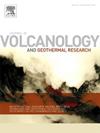熔融粘度跟踪 2021 年拉帕尔马(加那利群岛)塔霍加岩喷发的火山和岩浆演变过程
IF 2.4
3区 地球科学
Q2 GEOSCIENCES, MULTIDISCIPLINARY
Journal of Volcanology and Geothermal Research
Pub Date : 2024-11-01
DOI:10.1016/j.jvolgeores.2024.108210
引用次数: 0
摘要
经过 50 多年的沉寂之后,2021 年 9 月 19 日,加那利群岛拉帕尔马的坎布雷维埃哈山脊开始了火山爆发。喷发和爆炸活动共同形成了一个 12 平方公里的熔岩流场,新的火山锥比喷发前的地形高出近 200 米,并形成了巨大的火山灰毯。喷发的混合性质和观察到的喷发强度变化促使我们以高时间分辨率对大量液体粘度进行了深入研究。在长达 85 天的喷发过程中(直至 2021 年 12 月 13 日喷发结束),以接近每日的分辨率采集了 82 个熔岩样本。所有样本都经过了重熔,并在同心圆筒粘度计中测量了从 1490 °C 到初始结晶温度的液体粘度。这些数据是迄今为止针对喷发序列获得的时间分辨率最高的粘度数据集:1)在裂缝打开和形成阶段(第 1-20 天),熔体粘度呈线性下降;2)在喷发持续时间的大部分时间(第 21-70 天),粘度保持不变;3)从第 70 天开始到喷发结束,粘度再次上升。我们将这种模式解释为岩浆在喷发过程中被从管道系统的不同部分抽取出来。因此,我们表明粘度时间序列有助于揭示火山管道系统的一些复杂性。此外,研究结果还强调了粘度评估方法的监测潜力,特别是在利用岩浆流动性的直接信息预测喷发行为和检测岩浆管道系统动态变化方面。本文章由计算机程序翻译,如有差异,请以英文原文为准。
Melt viscosity tracks the volcanic and magmatic evolution of the 2021 Tajogaite eruption, La Palma (Canary Islands)
After more than 50 years of repose, on September 19th, 2021, a volcanic eruption began at the Cumbre Vieja ridge on La Palma, Canary Islands. The combined effusive and explosive activity generated a > 12 km2 lava flow field with a new cone nearly 200 m higher than pre-eruptive topography and a vast tephra blanket. The immediate impact was locally devastating, destroying nearly 2000 buildings, blocking two main and numerous secondary roads, and inundating high-value agricultural land.
The hybrid nature of the eruption and the observed variations in eruption intensity motivated a thorough investigation of bulk liquid viscosity at high temporal resolution. Collection of 82 lava samples was achieved at a near daily resolution over the course of the 85-day-long event (through the end of the eruption on December 13th, 2021). All the samples were remelted, and liquid viscosity was measured in a concentric cylinder viscometer from 1490 °C down to incipient crystallization temperatures. These data constitute the highest temporal resolution viscosity dataset obtained for an eruptive sequence to date.
A tripartite viscosity pattern is identified at isothermal conditions: 1) during the fissure opening and establishing stage (days 1–20) a linear decrease in melt viscosity occurred; 2) during most of the eruption duration (days 21–70) viscosity was constant and 3) from day 70 until the end of the eruption viscosity increased again. We interpret this pattern as magma being extracted from different parts of the plumbing system over the course of the eruption. Accordingly, we show that viscosity time series can help shed light on some of the complexities of volcanic plumbing system. Additionally, the presented results highlight the monitoring potential of the viscosity assessment approach, specifically in regard to forecasting eruption behavior using direct information about magma mobility and detecting changes in magmatic plumbing system dynamics.
求助全文
通过发布文献求助,成功后即可免费获取论文全文。
去求助
来源期刊
CiteScore
5.90
自引率
13.80%
发文量
183
审稿时长
19.7 weeks
期刊介绍:
An international research journal with focus on volcanic and geothermal processes and their impact on the environment and society.
Submission of papers covering the following aspects of volcanology and geothermal research are encouraged:
(1) Geological aspects of volcanic systems: volcano stratigraphy, structure and tectonic influence; eruptive history; evolution of volcanic landforms; eruption style and progress; dispersal patterns of lava and ash; analysis of real-time eruption observations.
(2) Geochemical and petrological aspects of volcanic rocks: magma genesis and evolution; crystallization; volatile compositions, solubility, and degassing; volcanic petrography and textural analysis.
(3) Hydrology, geochemistry and measurement of volcanic and hydrothermal fluids: volcanic gas emissions; fumaroles and springs; crater lakes; hydrothermal mineralization.
(4) Geophysical aspects of volcanic systems: physical properties of volcanic rocks and magmas; heat flow studies; volcano seismology, geodesy and remote sensing.
(5) Computational modeling and experimental simulation of magmatic and hydrothermal processes: eruption dynamics; magma transport and storage; plume dynamics and ash dispersal; lava flow dynamics; hydrothermal fluid flow; thermodynamics of aqueous fluids and melts.
(6) Volcano hazard and risk research: hazard zonation methodology, development of forecasting tools; assessment techniques for vulnerability and impact.

 求助内容:
求助内容: 应助结果提醒方式:
应助结果提醒方式:


